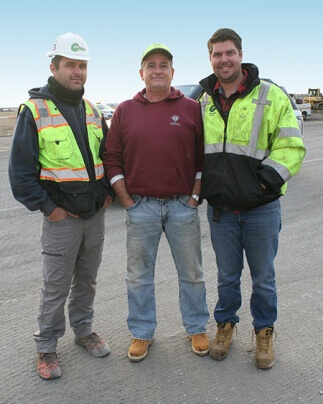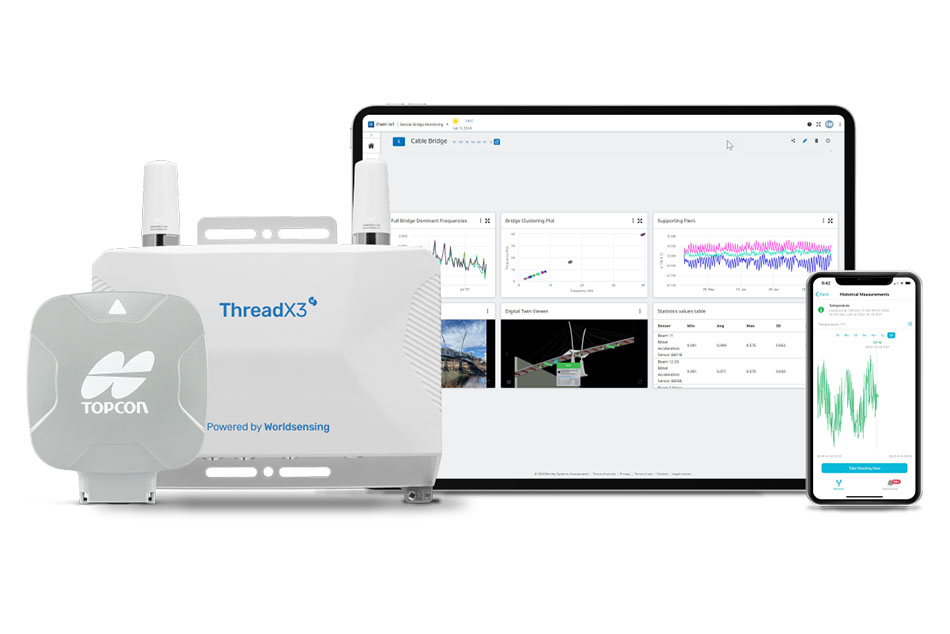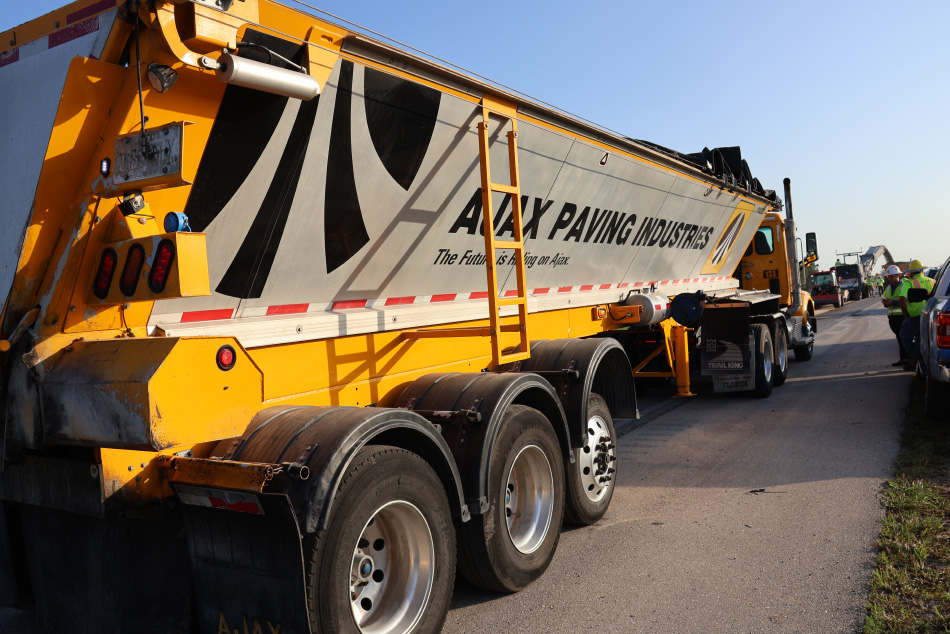
Ranked #16 on the list of the world’s busiest airports, New York’s JFK airport handles nearly 59 million passengers and 1.4 million tons of cargo annually. The area designated for warehouse and storage facilities to accommodate all that cargo alone, is the size of roughly 70 football fields. So when it is decided that regular periodic work needs to be done on several of the facility’s taxiways, the logistics of making that happen can be staggering and complex. It also become incumbent upon the firm heading up the repaving effort to get the work done as quickly and safely as possible to minimize impact on overall airport operations — and do so while maintaining tough milling and paving specs.
For Grace Industries, LLC (a division of the Haugland Group), that meant taking a step away from its traditional milling practices and embracing newer 3D milling technology. With three phases of a proposed 11-phase project completed, the result has been a milled surface which the facility’s owners called “The best we’ve ever seen,” and “Better than many paved surfaces.” Considering that people from the metro New York area are not easily impressed, that’s some high praise — and a solid vote of confidence for the 3D solution.
"It is all about maintaining grade and that is precisely what the 3D system ensures."
John Biscardi, project manager for Grace Industries, LLC
Solid Reputation
The company currently known as Grace Industries, LLC was formed when electrical contractor William Haugland acquired an asphalt plant from the W. L. Grace family. Though he sold the plant some four years later to the New York State DOT, he brought his sons William Jr. and Joseph (J.J.) into the business to begin growing a civil construction company from the ground up. That business, and an electrical firm started when Haugland’s non-compete agreement from his previous business had expired, form the bulk of what is today’s Grace Industries.
“Even though that was just 13 years ago, we currently employ between 700 and 800 people and, between those two main divisions, generate annual sales in the $350 million range,” said J.J. Haugland, Grace’s VP of project development and operations. “The construction division specializes in milling/paving, concrete and bridge deck work, sewer and other drainage work, and storm cleanup, while underground utilities have been the bread and butter area for Haugland Energy, our utility construction division. Over the years we’ve developed a solid reputation for high quality infrastructure work which has allowed us to secure a good many municipal contracts — including the one for the Port Authority of NY/NJ to mill and repave Taxiway Q at JFK.”
While major airport runways generally undergo a repaving effort every five years, taxiways last a bit longer: seven to ten years between upgrades. Valued at more than $31 million, the JFK project involves the rehab of nearly two miles of taxiway that, in some areas, measures up to 200 feet in width. The high-profile nature of the project, (work took place during U.N. Week, in which world dignitaries were flying into and out of the airport), coupled with a tight schedule, prompted the Grace team to rethink its proposed milling methods. “We have always been big believers in 3D machine control for our earthmoving equipment,” said Haugland. “So when John Biscardi, our project manager, mentioned that he had worked with Jim Cleary from Cleary Machinery using 3D milling on a previous airport project, it made sense. The fact that the Port Authority is really making a push toward automation in its specs also came into play. Something of an authority in 3D applications, Jim was certain that this was a solution we needed — reassuring us that the technology had gotten even better since that last project, for example — and we agreed.”
2D or Not 2D?
To understand the benefits a contractor can derive from 3D milling, it is best to look at the traditional 2D milling approach which it is increasingly replacing. In a traditional airport milling setting, sensors use an external device such as a stringline as a surveying reference to maintain the desired milling profile. While accurate, the shortcomings of stringline — human error, string movement or damage, difficulty meeting tight tolerances, risk of material over- or under-removal, etc. — can not only hamper production, they also result in increased costs. By comparison, the approach Cleary was proposing, a Topcon Millimeter GPS system, draws upon the strength and accuracy of a 3D digital design model. Then, an array of rotating laser transmitters located alongside the taxiway creates a laser zone which the 3D system on the milling unit accesses to determine elevation and set the necessary depth of the milling drum. This laser zone is more efficient than optical control which requires line of sight from instrument to prism. When signal blockages occur, millimeter recovers instantly regardless of rover position.
“It is all about maintaining grade and that is precisely what the 3D system ensures,” said Biscardi. “The engineers design the grades and we pave to that design. If we are out within .5” either way, we are penalized — it’s as simple as that. Just as in vertical construction, if you have a foundation that is proper, things will go smoothly. If you have a foundation that has issues, going upward will be a problem. I worked with Jim on an airport job in Newark in 2009 with a similar, but less sophisticated system and knew that this was the way to go.”
Grace Under Pressure
Grace’s decision to choose the 3D milling solution at JFK is an apt representation of what Topcon calls the “Intersection of Infrastructure and Technology.” The company describes it as a conceptual crossroads at which Topcon provides industry professionals like Grace with the advantages and know-how to be at the forefront of technological innovation. Those professionals then benefit from the resultant increase in productivity and profitability — and a better ability to meet growing infrastructure needs.
According to Paul Ceglia, Grace’s party chief, the solution quickly rose to the occasion and opened more than a few eyes in the process.
“The accuracy has been amazing,” he said. “While it’s possible to mill manually and stay within the ½” spec, consistency is what we are looking for and the 3D grade control provides that. We took a bit of a different approach out here, in that we used a pair of Wirtgen W201i seven-foot milling machines provided by Komatsu Northeast (Holbrook, N.Y. branch) — one running the Topcon system, the other without. In that way, because we were able to control both sides of the drum on the Topcon-equipped unit, we were able to skip passes and the other miller was able to simply go in and match on either side. On Phase 3, we basically had 1600 feet of taxiway milling done by noon — three hours ahead of schedule. The crew was ecstatic and wanted to start milling elsewhere on the job; it was impressive to see. And the numbers speak for themselves — the Port Authority said this is one of the best milled surfaces they’ve seen. That’s a nice endorsement.”
“More noteworthy, however, is the fact that they are within ±.25" spec 80 to 85% of the time.”
Jim Cleary, Cleary Machinery
Bench is Deep
Even an impressive GNSS solution is only as good as the benchmarks set for it and in that regard, Grace, being a survey-focused company, errs on the side of caution. Working with Ceglia, Vince DiCairano, the Port Authority’s senior engineering survey supervisor, drew upon older, proven benchmark techniques to guarantee the success of the new approach.
“We took an ‘old-school’ approach, using three-wire levelling for the project and I feel it’s made a difference,” he said. “Our original bench run started two miles west and we did another from two miles east and we closed to within .02, which is almost unheard of. On a project like this, the horizontal numbers can be a couple hundredths off but the vertical has to be within thousandths — these bench runs gave us that. As a result, we were looking for milling to be within .5 to .25 (high or low), and these guys are hitting it well.”
“Hitting it well,” might just be a huge understatement at JFK. According to Jim Cleary, Grace’s crew consistently milled to within ±.5" spec on 100% of shots taken. “More noteworthy, however, is the fact that they are within ±.25" spec 80 to 85% of the time,” he said. “We expected that number to be around 75%, so we were pleased. But on Phase 3, the joint survey produced a large area of milled subgrade that was ± .25" on 95% of the shots. That prompted the Port Authority to say those were the best numbers they’d ever seen — including top of asphalt. Not bad for a milled surface. The Topcon Millimeter GPS solution gives a contractor like Grace the ability to mill this accurately every time out.”
Added Benefits
Ceglia noted that using Millimeter GPS also helped ensure that material costs were controlled as well. “With this technology, you’re going to get a better product — there’s no doubt about that,” he said. “However, you will also mill just exactly what you bid. I built two models for this project: an original ground surface as well a finished design. This surface isn’t a perfect 3-inch mill — sometimes it’s 2” sometimes 1 ½” — so I have a take-off number to compensate for that. But, because the grade control will hold us at 3” below finished grade the whole time, our quantities — projected at 3,000 tons for Phase 3 alone — will be accurate.”
In the course of the JFK project Ceglia became something of a fan of the laser-centered millimeter GPS approach. He particularly cited the shortcomings of a robot — up to this point, their go-to technology.
“Typically, with a robot, you can only go so many feet around the radius of the instrument until your elevations start losing the tolerances you want to keep. The lasers, on the other hand, offer a 300 foot radius around them. So when I set up the lasers all along the taxiway here, I had a laser level line throughout the whole site, which meant I could walk the whole site and get a mint grade anywhere. The speed of that alone is invaluable, but to have a benchmark anywhere I go, is awesome.”
Tapping Other Technologies
The success Grace is seeing at the JFK project is largely the result of the belief management has in evolving technology. According to J.J. Haugland, he firmly feels that resisting the changes taking place with regard to 3D machine control would be self-defeating.
“Over the last few years, technology has been growing by leaps and bounds, and much of what’s becoming available can directly impact the productivity of an operation,” he said. “The construction industry tends to be a little slow in embracing change, so I feel our acceptance of new and better solutions is what separates us from many of the others working today. I’m convinced that, being a young company with the willingness to put these changes to work for us, can really help as we move forward. We are only in the preliminary phase of consideration, but I am definitely interested in seeing what 3D can do for our paving operation, I am intrigued by intelligent compaction, I’d like to examine grade control for excavators for our underground work. There’s a lot that interests me out there.”
In an industry in which the survey operation is being increasingly subcontracted out, Grace has instead embraced survey and all that it can do for them. Haugland says, in fact, that he sees his surveyors as key to their success to date.
“Our survey team — Rich and Shawn Ness, Paul Ceglia and George Zaniel — are our backbone; everything literally starts and ends with them,” he said. “In addition to their on-site work, we utilize them to the fullest, particularly with regard to 3D modeling. Their expertise in that area allows us to be more competitive in our bidding process; we create 3D models for everything during the bid. Then, once we get the job, that 3D model turns into our job model, so all the info they’ve compiled affords us a leg up on the job. Then, after continually updating that file, we can turn over a fully detailed as-built model to the customer. We can show them: ‘This is what was bid, ‘This is a change condition,’ ‘This is what we actually did,’ ‘This is the final product,’ and so on. It very comparable to how vertical construction uses BIM.”
Clearly Cleary
While the switch to 3D milling could have been a huge disruptive undertaking, all parties involved in the JFK taxiway project point to the outstanding level of support provided by Cleary throughout as having helped prevent that.
“Jim has been amazing out here; you will find him on site any time we are milling,” said Ceglia. “He is always thinking of ways to improve the process and If there is any kind of issue, he is right there to help resolve it. Before choosing the Topcon Millimeter GPS, we were looking at using an alternative system. But Jim’s knowledge of the technology and his commitment to the project won us over.”
Grace has now wrapped up the first three phases of the JFK taxiway project and will be winding down operations until Spring. For Haugland, the work done to date has been a great source of pride in his team.
“We have an amazing organization — one in which everyone is always striving to get better. I genuinely don’t feel like I’m going to work each day — it’s more like I am going to do something I love and be with people I enjoy being around. This 3D milling project was a test for many of them and there’s no doubt they passed with flying colors. To see those excellent results sprayed on the milled surface is a great feeling. I couldn’t be prouder.”















